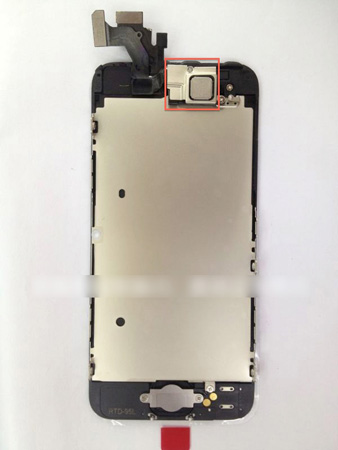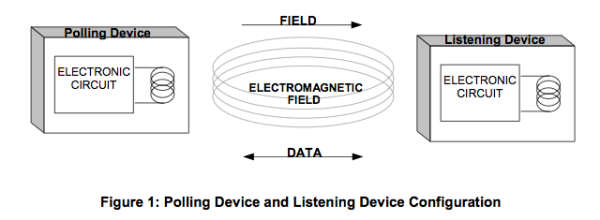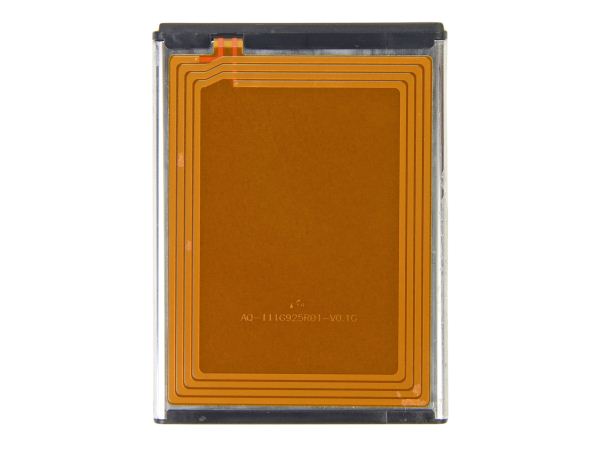Preparing for the iPhone Next: Rumors Analyzed
by Brian Klug & Anand Lal Shimpi on August 27, 2012 9:40 PM EST- Posted in
- Smartphones
- Apple
- Mobile
- iPhone
NFC, Unlikely
The most recent rumor is that this mysterious square chip (occluded by an EMI can) is an NFC combo controller and antenna, based purely on its square dimensions.

The NFC "chip" ensquared in red
Given the primarily metal backside of the new iPhone, it's highly unlikely that NFC is in the cards for this generation. In fact, given the very little space at top and bottom dedicated to those glass RF windows, you can almost entirely rule it out.
NFC operates on the 13.56MHz ISM band, which has a relatively large wavelength, at 22.1 m. Making a traditional dipole antenna that radiates at all given the constraints of a smartphone package is thus a big challenge, considering that smartphones are maybe 5-inches tall at maximum, to say nothing of the supposed upcoming iPhone's longest linear dimension.

From the NFC Forum Analog Specification
As a result almost all NFC antennas are big inductors and work using a magnetic field coupled between a host and peer device. Since we're talking about an inductor, NFC antennas use as big of a coil of wire as possible with as many wires as possible tightly wound together, and thus often use as big of an unbroken 2D plane as they can get on the device. In the smartphone space, basically all NFC antennas to date are simply flat spirals on a PCB. Whether this gets hidden on top of the battery like what Samsung has done in recent devices, or printed on the back battery cover like earlier devices, the antenna is ultimately a big square or circle with as big and dense of a coil as possible.

Galaxy Nexus Battery and NFC Antenna Coils (Courtesy iFixit)
Getting a good inductor into the device is important because how much inductance your antenna has will determine maximum coupling distance and ease of alignment. It shouldn't need saying, but having a huge ground plane (the unibody metal back case) in the way of your NFC antenna will seriously degrade performance, thus only the top or bottom windows are logical places to put it.
It's this last point which makes us very skeptical about the top or bottom RF windows being used for a relatively small NFC loop – not because such a thing is impossible – but rather because of how terrible the resulting ease of alignment and maximum coupling distance would be. Most NFC implementations at present place the inductive coils as near to the center of the device as possible, partly because this is the most optimal way to maximize the area which can be dedicated to it, partly because it makes alignment natural. With an NFC antenna at the extreme top or bottom, alignment with non-iPhones (for example, payment tokens or reader tags) becomes a much more confusing task, and that doesn't seem like the Apple-like level of polish everyone is waiting for to drive NFC adoption.

There's also a healthy number of signaling pins in the flex cable leaving the mystery chip, some of which appear to be signaling for the front facing camera which is part of the assembly, others for earpiece, proximity, and ambient light sensor. In addition this assembly also is obviously the assembled display and touch stack. When you consider the inclusion of in-cell touch sensing which has been rumored for the upcoming iPhone, and the requirement for time multiplexing of both display driving and touch sensing signals (to mitigate interference and make this possible), it's more likely that the components under that heavily shielded (and grounded with a big spring finger) EMI can are the touch and display controller combo that need to work in conjunction for in-cell to be possible.
The inclusion of Passbook in iOS 6 is the most often-cited piece of evidence for Apple including NFC, which seems a bit paradoxical since Apple hasn't disclosed at all whether it would favor NFC or a Bluetooth LE (low-energy) or even QR code based payment token through that gateway.










131 Comments
View All Comments
solipsism - Monday, August 27, 2012 - link
"Thus it seems highly likely that Apple will also move to this chemistry given maturity and the tangible benefits it provides to battery lifetime."What do you mean by maturity and tangible benefits? Why couldn't any of these vendors used 3.8V before?
mfenn - Monday, August 27, 2012 - link
You don't just call up the battery fairy and ask her to set your battery to a certain voltage. Instead, a battery's terminal voltage is largely determined by the different compounds that you use as the anode and cathode, hence chemistry.aguilpa1 - Tuesday, August 28, 2012 - link
Well I called up the battery fair..., she put me on hold.ImSpartacus - Wednesday, September 5, 2012 - link
Is the Battery Fairy a meme yet?http://www.anandtech.com/show/6230/the-anandtech-p...
Brian Klug - Monday, August 27, 2012 - link
Well Motorola used the 3.8 V nominal chemistry for over a year successfully. I guess what I mean is that for Apple to ship that (and now we see Samsung doing the same with SGS3, Nokia with PureView 808, etc) the cell chemistry and manufacturing needs to be mature enough that they're guaranteed volume sufficient for it to not be the limiting component in the supply chain.-Brian
Penti - Wednesday, August 29, 2012 - link
If the Koreans and Japanese can build the cells then the Taiwanese firms / suppliers building Apples batteries can also utilize 3.8 V chemistry obviously. Hardly a technology that Apple would push much but it seems the 3.8V nominal tech is mature. As you say. Tooling and process would appear to work out if it's already out in tens of millions of devices. Really depends on requirements from Apple, it's not like they have set their mind on a particular cell supplier or battery assembly company. If they can source it successfully from the battery suppliers I doubt they care much about the details further back the supply chain so long that they or those companies can keep up and deliver. It's technology only a few companies in the world have mastered, we in the west can at best hope to assemble the components here pretty much.Samsung SDI Cells according to the shots here, I would think they have that technology and manufacturing process well developed. Normally Dynapack and Simplo who assembles the batteries for them. We'll have to wait and see, at least they are hardly expected to move to high-capacity batteries. Don't know if BYD, LG Chem, Panasonic, Sony and the rest etc is ready to ship this chemistry though. Samsung SDI and LG Chem should have most of the market and have moved quite far along there. Using the best Samsung cells when it becomes a commodity makes sense I guess.
Azethoth - Tuesday, August 28, 2012 - link
You really do want to not blaze new trails with the battery since a wrong move can leave you with an incendiary product which is not that good for sales. Maturity means its been proven out on other devices that are not in your pants all day long.Jingato - Tuesday, August 28, 2012 - link
And people say Apple is Innovative.Nfarce - Tuesday, August 28, 2012 - link
Well they are certainly innovative at destroying competition.swb311 - Tuesday, August 28, 2012 - link
Destroying THE competition?